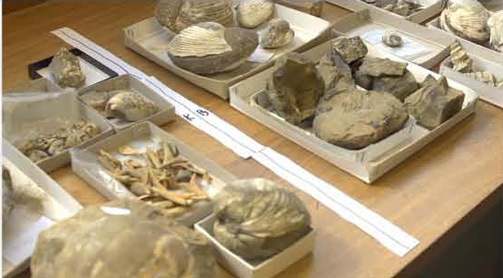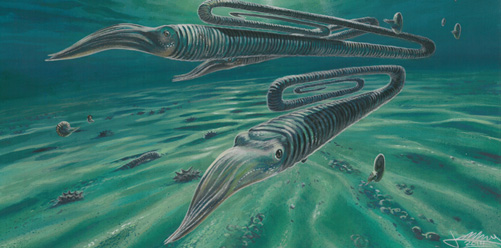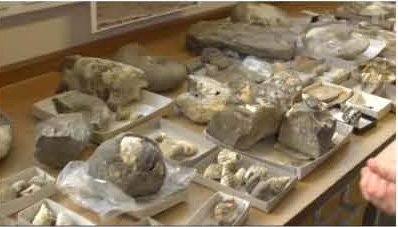A Global Catastrophe Caused End Cretaceous Extinction According to New Study
Study of Antarctic Fossils Provides Evidence for Rapid Extinction
The demise of the non-avian dinosaurs, their flying reptile cousins, many marine vertebrates and a whole host of other flora and fauna some 66 million years ago has been well documented. However, debate still rages over the cause or the causes of this mass extinction event at the Cretaceous-Palaeogene (K-Pg) boundary. Was this extinction sudden and dramatic, caused by a catastrophic event such as an extraterrestrial impact or was it a gradual decline with many genera becoming extinct but over a longer period of time, perhaps as a result of global climate change?
Antarctic Fossils
A new study published recently in the journal “Nature Communications” suggests that the extinctions were rapid. Analysis of sediment from Seymour Island in the Antarctic Peninsula indicates that there was a rapid and severe decline in marine fauna, this study supports the hypothesis that rather than a slow, gradual decline the K-Pg boundary represents a very rapid mass extinction event.
A Dramatic Reduction in the Number and Variety of Fossils
Picture credit: Leeds University
Working on the remote Seymour Island in Antarctica, scientists from Leeds University along with researchers from the British Antarctic Survey, mapped and explored a series of highly fossiliferous marine sediments that date from approximately 69 million years ago through to around 65 million years ago.
Recording an Extinction Event Thanks to Antarctic Fossils
James Witts, a PhD student in the School of Earth and Environment (Leeds University), lead author of the scientific paper, was instrumental in identifying the various fauna that the 6,000 fossils represented. It was then a case of ensuring that the fossils were documented in the correct stratigraphic sequence and from this, the researchers were able to conclude that there was a sudden reduction in the number of species living in Antarctic waters some 66 million years ago. Around two thirds of the species disappear from the fossil record, at a time that coincides with the dinosaur extinction (K-Pg boundary).
In the picture above the K-Pg boundary is represented by the white paper strip. There is a band of rocks in which no fossils can be found and in younger sediments deposited later, only a handful of different species are represented
A Sudden and Catastrophic Event
Student James commented:
“Our research essentially shows that one day everything was fine, the Antarctic had a thriving and diverse marine community and the next, it wasn’t. Clearly, a very sudden and catastrophic event had occurred on Earth. This is the strongest evidence from fossils that the main driver of this extinction event was the after-effects of a huge asteroid impact, rather than a slower decline caused by natural changes to the climate or by severe volcanism stressing global environments.”
A Rich and Diverse Maastrichtian Marine Ecosystem
This study is the first to conclude that the mass extinction that marked the end of the dinosaurs, pterosaurs and many other forms of life, was a truly global event and that it was just as sudden in high latitudes as it was in lower latitudes. In short, the polar ecosystems were hammered too.
The fossils from the Late Maastrichtian strata that pre-date the extinction event indicate a rich and highly diverse marine food web populated by a huge array of molluscs such as gastropods, bivalves and cephalopods. In turn, there were large numbers of different types of fish, the fish shared the shallow sea with a variety of marine reptiles including mosasaurs. Numerous soft bodied organisms such as sea slugs, anemones, starfish and jelly fish would also have been present but their remains are not frequently preserved as fossils.
Peculiar Mollusces – Unravelling Ammonites
One of the more peculiar molluscs known from the Upper Cretaceous rocks of Seymour Island is the giant ammonite Diplomoceras. This invertebrate, related to modern day cuttlefish and squid had a shell that uncoiled to a large extent. It resembled a two-metre-long paper clip. Although Diplomoceras fossils are found in rocks older than 66 million years, just like the rest of the ammonites, its fossils are absent in rocks laid down in the Palaeogene Epoch.
For models and replicas of ammonites and other prehistoric creatures: CollectA Prehistoric Life Figures.
An Illustration of the Bizarre Ammonite Diplomoceras
Picture credit: James McKay
Although the majority of ammonites had coiled shells, a number of families evolved in the Early Cretaceous with shells that were uncoiled to varying degrees. In 2012, Everything Dinosaur wrote an article detailing research undertaken by scientists from the Natural History Museum of Vienna that provided an explanation for this adaptation.
To read more: Unravelling the Mystery of the Unravelling Ammonite.
A Rich and Diverse Marine Fauna – Prior to the Extinction Event
Picture credit: Leeds University
Everything Dinosaur acknowledges the help of Leeds University in the compilation of this article. This blog post has also been constructed with reference to the academic paper: “Macrofossil evidence for a rapid and severe Cretaceous–Paleogene (K–Pg) mass extinction in Antarctica”, published in the journal Nature Communications in May 2016.
Visit Everything Dinosaur’s website: Everything Dinosaur.




